1986 CHEVROLET CORVAIR air condition
[x] Cancel search: air conditionPage 17 of 56
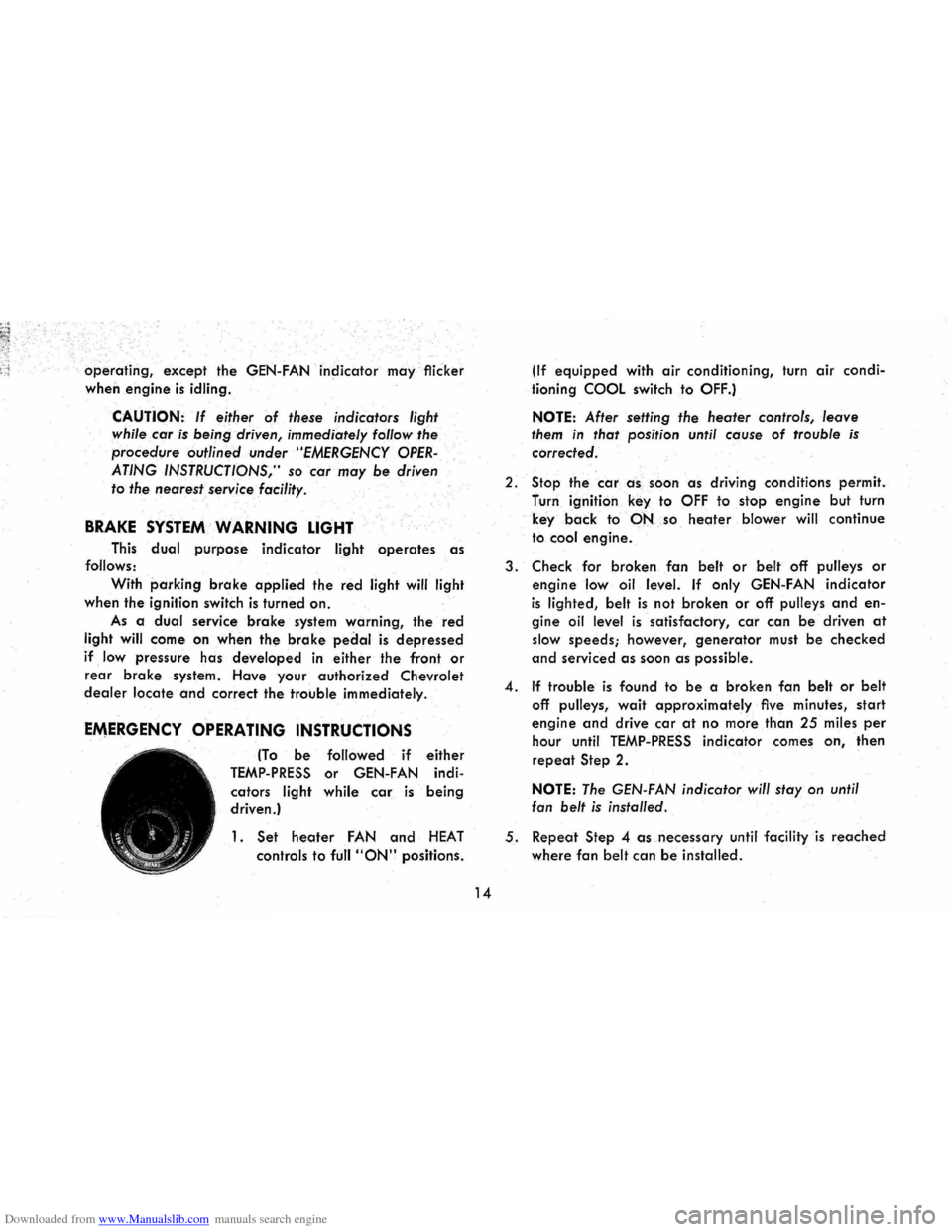
Downloaded from www.Manualslib.com manuals search engine operating, except the GEN-FAN indicator rna)' flicker
when
engine is idling.
CAUTION: If either of these indicators light
while .
car is being. -driYen, immediately follow the
procedure outlined .vnder "EMERGENCY OPER
ATING INSTRUCTIONS," so car may be driyen
to the nearest service facility.
BRAKE SYSTEM WARNING LIGHT
This dual purpose indicator light operates as
follows:
With parking brake applied the red light will light
when
the ignition switch is turned on.
As a dual service brake system warning, the red
light will come on when the brake pedal is depressed
if low pressure has developed in either the front or
rear brake system. Have your authorized Chevrolet
dealer locate and correct the trouble immediately.
EMERGENCY OPERATING INSTRUCTIONS
(To be followed if either
TEMP-PRESS or GEN-FAN indi
cators
light while car is being
driven.)
1. Set heoter FAN and HEAT
controls to full "ON" positions.
14
(If equipped with air conditioning, turn air condi
tioning
COOL switch to OFF.)
NOTE: After setting the heater controls, leave
them in that position until cause of trouble is
corrected.
2.
Stop the car a -s , soon as driving conditions permit.
furn ignition
key to OFF to stop engine but turn
key
back to·-PNso heoter blower will continue
to
cool engine.
3. Check for broken fan belt or belt off pulleys or
engine low oil level. If only GEN-FAN indicator
is lighted, belt is not broken or off pulleys and en
gine oil level is satisfactory, car can be driven at
slow speeds; however, generator must be checked
and serviced as soon as possible.
4. If trouble is found to be a broken fan belt or belt
off pulleys, wait approximately five minutes, start
engine and drive car at no more than 25 miles per
hour until TEMP-PRESS indicator comes on, then
repeat Step 2.
NOTE: The GEN-FAN indicator will stay on until
fan
belt is installed.
5. Repeat Step 4 as necessary until facility is reached
where fan belt can be installed.
Page 21 of 56

Downloaded from www.Manualslib.com manuals search engine switch is turned to the "ON" position, the warning light
glows red to indicate to the operator that the parking
brake has not been fully released. This also indicates
that the brake warning light is operational. If the light does not come on, have your Corvair Dealer correct
the trouble as soon as possible. The other function of
this light is to indicate a malfunction in the regular braking system. In the event of broken brake lines,
major brake fluid loss, air in the brake lines or a pres
sure deviation between the front · and the rear wheel
brake lines, the light will come on and stay on while
braking .
In this event, the vehicle should not be driven
until
the cause has been determined and, if necessary,
corrected.
Automatic Brake Adjusters
All Corvair models are equipped with self-adjusting
brakes which eliminates periodic brake adjustments. The
self-adjusting mechanism
is actuated, as needed, when
ever the car is moved in reverse and the brakes applied.
It is possible, however, for excessive brake pedal travel
to
develop if the required reverse movement with a
brake application does not take place during a pro
longed
period of stop and go forward driving. Should
this occur,
the car should be driven backward and for
ward with the brakes applied at the end of each direc
tional movement, until the brake pedal travel is back to
normal. If this procedure fails to restore normal pedal
travel, or if any abnormally rapid increase in pedal
travel is experienced, immediate inspection should be
made by your Authorized Chevrolet Dealer. Care should
18
be exercised to assure that full brake pedal travel can
not be obstructed by improper floor mats or other inter
fering material under the pedal.
PARKING BRAKE
The parking brake operates by cables on the rear
wheel brakes independent of the regular foot brake hydraulic system. The brake system warning light will
be "ON" whenever the parking brake is not fully re
leased and the ignition switch is "ON". Never drive the car with the parking brake engaged. .
Pull the parking brake lever as far as possible to
engage the brake. The lever will remain in the applied
position until released. To release, pull the handle to
ward the steering wheel, depress the "trigger" and
allow the handle to return to the released position. CAUTION: When leaving the car unattended, always
fully apply the parking brake.
WINDSHIELD WIPER AND WASHER
The windshield wiping
system operates at (2)
speeds and is designed to
wipe clear
designated areas
of the windshield under
most inclement weather
conditions. The windshield
wipers work
electrically and
are not affected by engine
operation.
Exposure to the "ele
ments" tends to "wear out"
OFF~ON
Page 22 of 56
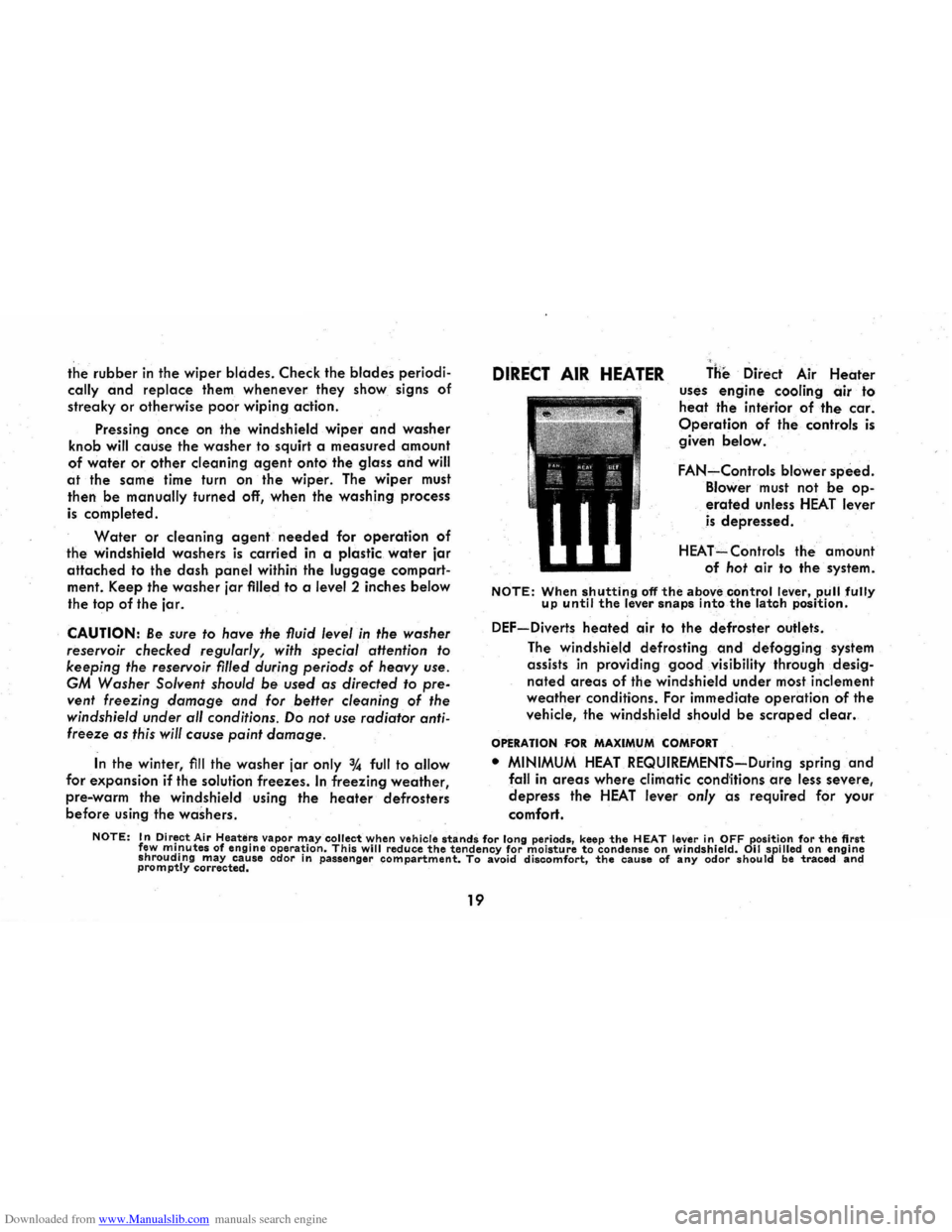
Downloaded from www.Manualslib.com manuals search engine the rubber in the wiper blades. Check the blades periodi
cally and replace them whenever they show signs of
streaky or otherwise poor wiping action.
Pressing
once on the windshield wiper and washer
knob will cause the washer to squirt a measured amount
of water or other cleaning agent onto the glass and will
at the same time turn on the wiper. The wiper must
then
be manually turned off, when the washing process
is completed.
Water or cleaning agent needed for operation of
the windshield washers is carried in a plastic water jar
attached to the dash panel withiri the luggage compart
ment. Keep the
washer jar Ailed to a level 2 inches below
the top of
the jar.
CAUTION: Be sure to have the fluid level in the washer
reservoir
checked regularly, with special attention to
keeping the reservoir fil/ed during periods of heavy use.
GM Washer Solvent should be used as directed to pre
vent freezing
damage and for better cleaning of the
windshield under
aI/ conditions. Do not use radiator anti
freeze as this will cause paint damage.
In the winter, fill the washer jar only % full to allow
for expansion if the solution freezes. In freezing weather,
pre-warm the windshield using the heater defrosters before using the washers.
DIRECT AIR HEATER THe Direct Air Heater uses engine cooling air to
heat the interior of the car.
Operation of the controls is
given below.
FAN-Controls blower speed.
Blower must not be op
erated unless HEAT lever
is depressed.
HEAT=Controls the amount
of hot air to the system.
NOTE: When shutting off the above control lever, pull fully up until the lever snaps into the latch position.
DEF-Diverts heated air to the defroster outlets.
The windshield defrosting
and defogging system
assists
in providing good visibility through desig
nated areas of the windshield under most inclement
weather conditions. For immediate operation of the
vehicle, the windshield should
be scraped clear.
OPERATION FOR MAXIMUM COMFORT
• MINIMUM HEAT REQUIREMENTS-During spring and
fall in areas where climatic conditions are less severe,
depress the HEAT lever only as required for your
comfort.
NOTE: In Dir~ct Air Heauirs vapor m.ay collectwhen vehicle stands for long periods, keep the HEAT lever in OFF position for the first few ml!lutes of engine operatIon. This will reduce the tendency for moisture to condense on windshield. 011 spilled on engine shroudIng may cause odor in passenger compartment. To avoid discomfort, the cause of any odor should be traced and promptly corrected.
19
Page 23 of 56
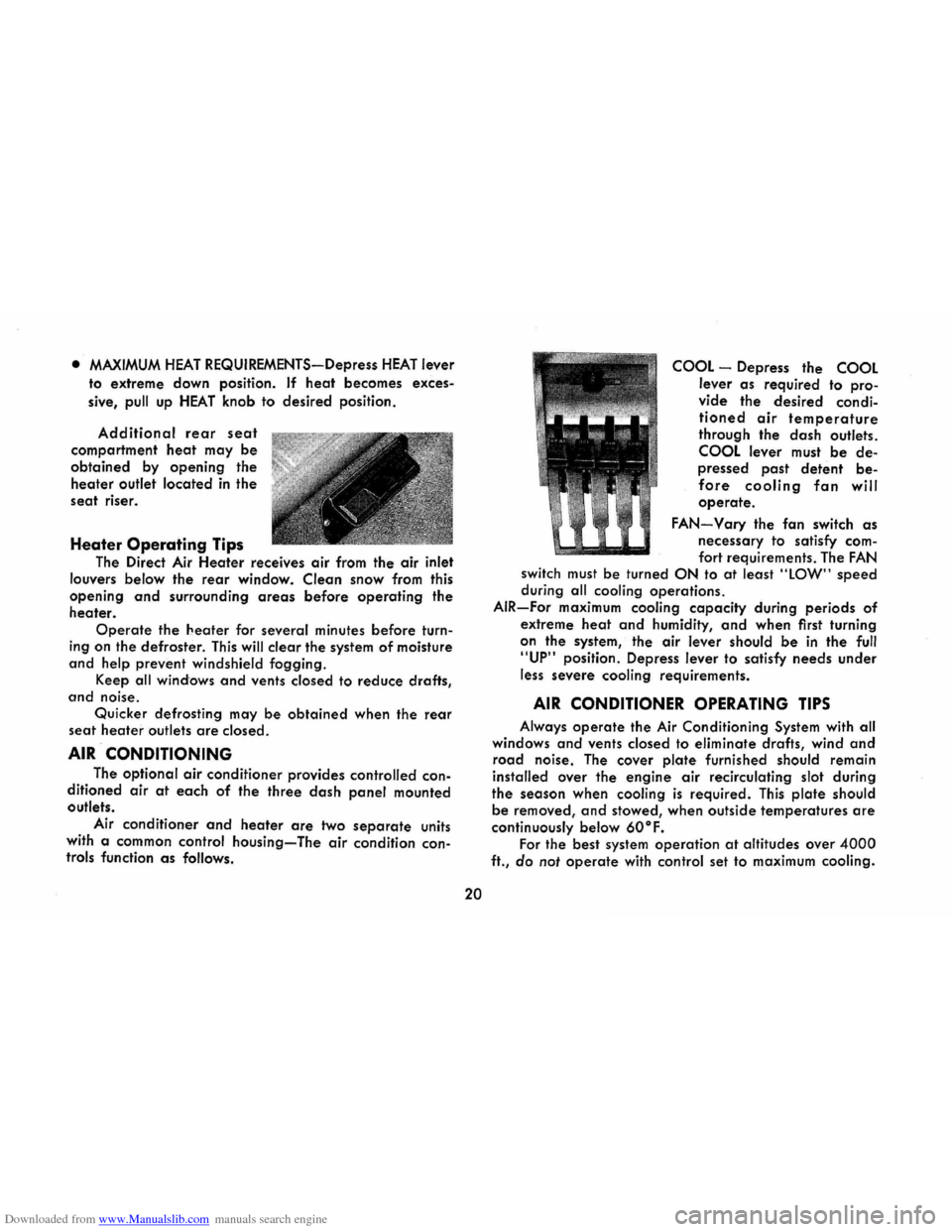
Downloaded from www.Manualslib.com manuals search engine • MAXIMUM HEAT REQUIREMENTS-Depress HEAT lever
to extreme down position.
If heat becomes exces
sive, pull up HEAT knob to desired position.
Additional rear seat
compartment heat may be
obtained by opening the
heater outlet located in the
seat riser.
Heater Operating Tips
The Direct Air Heater receives air from the air inlet
louvers below the
rear window. Clean snow from this
opening
and surrounding areas before operating the
heater.
Operate the heater for several minutes before turn
ing on the defroster. This will clear the system of moisture
and help prevent windshield fogging.
Keep
all windows and vents closed to reduce drafts,
and noise.
Quicker defrosting may
be obtained when the rear
seat heater outlets are closed.
AIR CONDITIONING
The optional air conditioner provides controlled con
ditioned air at each of the three dash panel mounted
outlets.
Air conditioner
and heater are two separate units
with a common control
housing-The air condition controls function as follows.
20
COOL -Depress the COOL
lever as required to pro
vide the desired condi
tioned air temperature
through the dash outlets.
COOL lever must be de
pressed past detent be
fore cooling fan will
operate.
FAN-Vary the fan switch as
necessary to satisfy com
fort requirements. The FAN
switch must be turned ON to at least "lOW" speed
during all cooling operations.
AIR-For maximum cooling capacity during periods of
extreme heat and humidity, and when first turning
on the system, the air lever should
be in the full
"UP" position. Depress lever to satisfy needs under
less
severe cooling requirements.
AIR CONDITIONER OPERATING TIPS
Always operate the Air Conditioning System with all
windows
and vents closed to eliminate drafts, wind and
road noise. The cover plate furnished should remain
installed over the engine air recirculating slot during
the season when cooling
is required. This plate should
be removed, and stowed, when outside temperatures are
continuously below 60°F.
For the best system operation at altitudes over 4000
ft., do not operate with control set to maximum cooling.
Page 33 of 56

Downloaded from www.Manualslib.com manuals search engine CLEANING HINTS
EXTERIOR APPEARANCE
Your Corvair is fi"nished with General Motors "Magi<=
Mirror" acrylic lacquer. This is a finish of maximum beauty
which, in depth of color, gloss retention and durability is
superior to conventional lacquer finishes.
Washing Your Corvair
Thebest way to preserve the finish is to keep it clean.
Normally only frequent washings are required to maintain
its original beauty. Wash the car in either warm or cold
(never hot)
water, notin the direct rays of the sun, and not
while the sheet metal surfaces are hot. Never wipe dirt
from dry
painted surfaces because this may scratch the
finish. The use
of strong soaps and chemical detergents
should
be avoided and in any event cleaning agents
should be promptly flushed from the surface (lnd not
allowed to dry or they may streak the finish.
Polishing and Waxing YourCorvair
Even though the acrylic paint on your car is more
durable than conventional finishes, under certaincondi
tions you may wish to wax or polish your car to provide
30
maximum protection. Calcium chloride and other salts,
road oil and tar, tree sap, chemicals from factory chim
neys and other foreign matter may damage any known
automobile finish if
allowed to remain in contact with the
paint
film. Prompt washing may not thoroughly remove
these deposits
and, particularly in geographical areas
where these exposure conditions are severe, properly
applied polishes and waxes of known quality will pro
vide the best protection. Chevrolet Dealers offer G.M.
Acry-Mel Hand Applied Cleaner and Polish and G. M.
Triple Acti()n
Cleaner and Polish; both are excellent for
use on acrylic finishes . Road oil
and tar removers must
be warranted safe for use on acrylic finishes. Chevrolet
recommends G. M. Road Oil and Tar Remover.
Protection of Exterior Bright Metal Parts
All bright metal parts of the car should be regularly
cleaned and protected against the same substances
harmful to the painted surfaces. Normally, washing with
water is all that is required. Never use chrome polish,
steam or any caustic soap to clean ALUMINUM. Wash
only with luke-warm water, and if necessary, a mild soap.
Rinse well and dry thoroughly. Severe cases may be
Page 35 of 56

Downloaded from www.Manualslib.com manuals search engine MAINTENANCE AND LUBRICATION
FUEL REQUIREMENTS
Your Corvair is designed to operate efficiently on
"Regular" or "Premium" grade fuels, commonly sold in
the United States and Canada, depending on the engine
installed in your car. The table below indicates the fuel
grade requirements for various Corvair engines.
ENGINE
95 H.P. TURBO-AIR
110 H.P. TURBO-AIR
140 H.P. TURBO-AIR
FUEL GRADE
Regular
Premium
Premium
Use
of a fuel which is too low in anti-knock quality
will result in "spark knock." Since the anti-knock quality
of all regular grade or of all premium grade gasolines
is not the same and factors such as altitude, terrain and
air temperature affect operating efficiency, knocking may
result even though you are using the grade of fuel rec
ommended for your engine. If persistent knocking is en
countered, it may be necessary to change to a higher
grade of gasoline and, If knocking continues, consult
your authorized Chevrolet Dealer.
In any case, continuous or excessive knocking may
result in engine damage and constitutes misuse of the en
gine for which the Chevrolet Motor Division is not re
sponsible under terms of the Manufacturer's New Vehicle
Warranty.
32
Operation in a Foreign Country
If you plan to operate your Corvair outside the con
tinental limits of the United States or Canada, there is
a possibility that the best fuels available are so low in
anti-knock quality that excessive knocking and serious
engine damage may result from their use. To minimize
this possibility,
write to Chevrolet Motor Division, Gen
eral Motors Corporation, Owner Relations Department,
Detroit,
Michigan 48202, giving: (1) The compression
ratio of your engine (see page 44 or obtain from your
dealer); (2) The vehicle identification number (see page
44); (3) The country or countries in which you plan to
travel.
You
will be furnished details of adjustments or
modifications which should be made to your engine by
your Chevrolet Dealer prior to your departure.
Failure to make the necessary changes in your car and
subsequent operation under conditions of continuous or
excessive knocking is considered misuse of the engine for
which the Chevrolet Motor Division is not responsible un
der terms of the Manufacturer's New Vehicle Warranty.
After arriving in a foreign country, contact the near
est authorized General Motors Dealer for brand names
of the best fuels available and advice as to where they
may be purchased.
Page 36 of 56
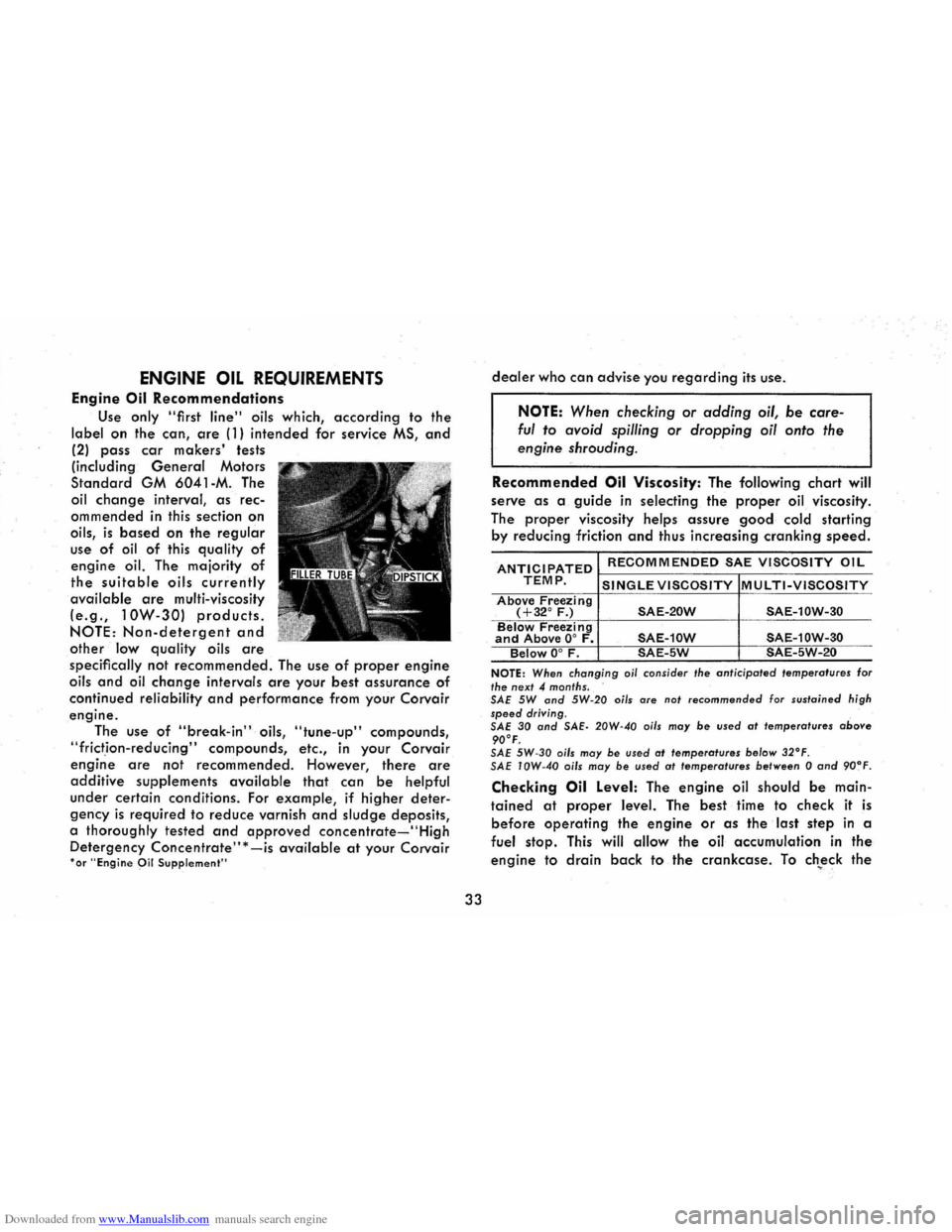
Downloaded from www.Manualslib.com manuals search engine ENGINE OIL REQUIREMENTS
Engine Oil Recommendations
Use only "first line" oils which, according to the
label on the can, are (1) intended for service MS, and
(2) pass car makers' tests
(including
General Motors
Standard GM 6041-M. The
oil
change interval, as rec
ommended in this section on
oils,
is based on the regular
use of oil of this quality of
engine oil. The majority of
the suitable oils currently
available are multi-viscosity
(e.g., 10W-30) products.
NOTE: Non-detergent and
other low quality oils are
specifically not recommended. The use of proper engine
oils and oil change intervals are your best assurance of
continued reliability and performance from your Corvair
engine.
The use of "break-in" oils, "tune-up" compounds,
"frictIon-reducing" compounds, etc., in your Corvair
engine are not recommended. However, there are
additive supplements available that can be helpful
under certain conditIons. For example, if higher deter
gency is required to reduce varnish and sludge deposits,
a thoroughly tested
and approved concentrate-"High
Detergency Concentrate" * -is available at your Corvair 'or "Engine Oil Supplement"'
33
dealer who can advise you regarding its use.
NOTE: When checking or adding oil, be care
ful to avoid spilling or dropping oil onto the
engine shrouding .
Recommended Oil Viscosity: The following chart will
serve
as a guide in selecting the proper oil viscosity.
The
proper viscosity helps assure good cold starting
by reducing friction and thus increasing cranking speed.
ANTICIPATED RECOMMENDED SAE VISCOSITY OIL
TEMP. SINGLE VISCOSITY MULTI-VISCOSITY Above Freezing (+32° F.) SAE-20W SAE-10W-30 Below Freezing and Above 0° F. SAE-10W SAE-10W-30 Below 0° F. SAE-5W SAE-5W-20
NOTE: When changing oi/ consider the anticipoted temperatures for the next 4 months.
SAE 5W and 5W·20 oils are not recommended for sustained high speed driving.
SAE 30 and SAE· 20W-40 oils may be used at temperatures above 90°F. SAE 5W-30 oils may be used at temperatures be/ow 32°F . SAE IOW-40 oils may be used at temperatures between 0 and 90~F.
Checking Oil Level: The engine oil should be main
tained at proper level. The best time to check it is
before operating the engine or as the last step in a
fuel stop.
This will allow the oil accumulation in the
engine to drain back to the crankcase. To ch~eck the
Page 38 of 56
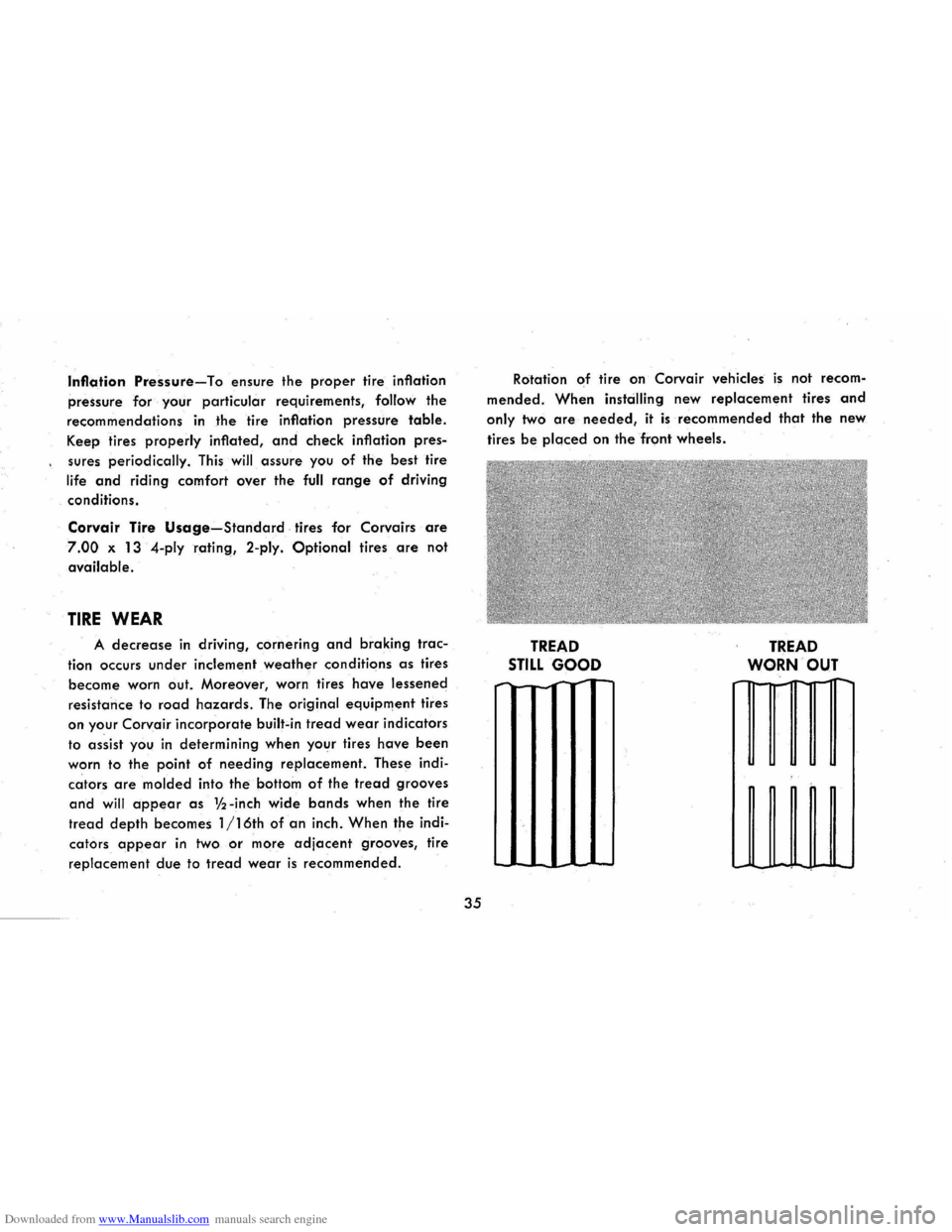
Downloaded from www.Manualslib.com manuals search engine Inflation Pressure-To ensure the proper tire inflation
pressure for your particular requirements,
follow the
recommendations
in the tire inflation pressure table.
Keep tires properly inflated,
and check inflation pres
sures periodically.
This will assure you of the best tire
life and riding comfort over the full range of driving
conditions.
Corvair Tire Usage-Standard tires for Corvairs are
7.00 x 13 4-ply rating, 2-ply. Optional tires are not
available.
TIRE WEAR
A decrease in driving, cornering and braking trac
tion occurs under inclement
weather conditions as tires
become worn out. Moreover, worn tires have lessened
resistance to
road hazards. The original equipment tires
on your Corvair incorporate
builtcin tread wear indicators
to assist you
in determining when your tires have been
worn to the point of needing replacement. These indi
cators
are molded into the bottom of the tread grooves
and will appear as % -inch wide bands when the tire
tread depth becomes 1 /16th of an inch. When the indi
cators
appear in two or more adjacent grooves, tire
replacement
due to tread wear is recommended.
35
Rotation of tire on Corvair vehicles is not recom
mended. When instcilling new replacement tires and
only two are needed, it is recommended that the new
tires
be placed on the front wheels.
TREAD
STILL GOOD
-
TREAD
WORN OUT .... .-